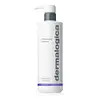What's inside
What's inside
 Key Ingredients
Key Ingredients

 Benefits
Benefits

 Concerns
Concerns

 Ingredients Side-by-side
Ingredients Side-by-side

Water
Skin ConditioningCetearyl Alcohol
EmollientBisabolol
MaskingZingiber Officinale Root Extract
MaskingLeuconostoc/Radish Root Ferment Filtrate
AntimicrobialGlycerin
HumectantAvena Sativa Kernel Extract
AbrasiveCucumis Sativus Fruit Extract
EmollientRubus Idaeus Fruit Extract
AstringentLavandula Angustifolia Flower Extract
CleansingSalix Alba Bark Extract
AstringentUsnea Barbata Extract
Butylene Glycol
HumectantPentylene Glycol
Skin ConditioningHydroxyphenyl Propamidobenzoic Acid
Skin ConditioningCitrus Medica Limonum Fruit Extract
Skin ConditioningFumaria Officinalis Flower/Leaf/Stem Extract
Skin ConditioningFumaric Acid
BufferingEchinacea Purpurea Extract
MoisturisingPanthenol
Skin ConditioningAcrylates/C10-30 Alkyl Acrylate Crosspolymer
Emulsion StabilisingCocamidopropyl Pg-Dimonium Chloride Phosphate
Disodium Lauryl Sulfosuccinate
CleansingCetrimonium Chloride
AntimicrobialAminomethyl Propanol
BufferingGlyceryl Caprylate
EmollientDisodium EDTA
Water, Cetearyl Alcohol, Bisabolol, Zingiber Officinale Root Extract, Leuconostoc/Radish Root Ferment Filtrate, Glycerin, Avena Sativa Kernel Extract, Cucumis Sativus Fruit Extract, Rubus Idaeus Fruit Extract, Lavandula Angustifolia Flower Extract, Salix Alba Bark Extract, Usnea Barbata Extract, Butylene Glycol, Pentylene Glycol, Hydroxyphenyl Propamidobenzoic Acid, Citrus Medica Limonum Fruit Extract, Fumaria Officinalis Flower/Leaf/Stem Extract, Fumaric Acid, Echinacea Purpurea Extract, Panthenol, Acrylates/C10-30 Alkyl Acrylate Crosspolymer, Cocamidopropyl Pg-Dimonium Chloride Phosphate, Disodium Lauryl Sulfosuccinate, Cetrimonium Chloride, Aminomethyl Propanol, Glyceryl Caprylate, Disodium EDTA
Water
Skin ConditioningGlycerin
HumectantSqualane
EmollientJojoba Oil/Macadamia Seed Oil Esters
Skin ConditioningIsosorbide Dicaprylate
Skin ConditioningPolyglyceryl-6 Distearate
EmulsifyingNiacinamide
SmoothingCeramide NP
Skin ConditioningCeramide Ns
Skin ConditioningCeramide AP
Skin ConditioningCeramide EOP
Skin ConditioningCeramide Eos
Skin ConditioningCholesterol
EmollientSodium Hyaluronate
HumectantXylitylglucoside
HumectantAnhydroxylitol
HumectantBetaine
HumectantXylitol
HumectantBeta-Glucan
Skin ConditioningHydrolyzed Jojoba Esters
Skin ConditioningJojoba Esters
EmollientGlucose
HumectantTocopheryl Acetate
AntioxidantTocopherol
AntioxidantAscorbyl Palmitate
AntioxidantSqualene
EmollientPhytosteryl Macadamiate
Skin ConditioningPhytosterols
Skin ConditioningCaprooyl Phytosphingosine
Skin ConditioningCaprooyl Sphingosine
Skin ConditioningSaccharide Isomerate
HumectantPolyglyceryl-3 Beeswax
EmulsifyingGlyceryl Caprylate
EmollientSodium Anisate
AntimicrobialEthylhexylglycerin
Skin ConditioningCetyl Alcohol
EmollientBehenic Acid
CleansingSodium Carrageenan
Emulsion StabilisingSea Salt
AbrasiveXanthan Gum
EmulsifyingAlgin
MaskingCarbomer
Emulsion StabilisingPolyacrylate Crosspolymer-11
Emulsion StabilisingCeteareth-25
CleansingSodium Citrate
BufferingSodium Hydroxide
BufferingCitric Acid
BufferingPhenoxyethanol
PreservativeBenzoic Acid
MaskingSorbic Acid
PreservativeWater, Glycerin, Squalane, Jojoba Oil/Macadamia Seed Oil Esters, Isosorbide Dicaprylate, Polyglyceryl-6 Distearate, Niacinamide, Ceramide NP, Ceramide Ns, Ceramide AP, Ceramide EOP, Ceramide Eos, Cholesterol, Sodium Hyaluronate, Xylitylglucoside, Anhydroxylitol, Betaine, Xylitol, Beta-Glucan, Hydrolyzed Jojoba Esters, Jojoba Esters, Glucose, Tocopheryl Acetate, Tocopherol, Ascorbyl Palmitate, Squalene, Phytosteryl Macadamiate, Phytosterols, Caprooyl Phytosphingosine, Caprooyl Sphingosine, Saccharide Isomerate, Polyglyceryl-3 Beeswax, Glyceryl Caprylate, Sodium Anisate, Ethylhexylglycerin, Cetyl Alcohol, Behenic Acid, Sodium Carrageenan, Sea Salt, Xanthan Gum, Algin, Carbomer, Polyacrylate Crosspolymer-11, Ceteareth-25, Sodium Citrate, Sodium Hydroxide, Citric Acid, Phenoxyethanol, Benzoic Acid, Sorbic Acid
 Reviews
Reviews

Ingredients Explained
These ingredients are found in both products.
Ingredients higher up in an ingredient list are typically present in a larger amount.
Glycerin is already naturally found in your skin. It helps moisturize and protect your skin.
A study from 2016 found glycerin to be more effective as a humectant than AHAs and hyaluronic acid.
As a humectant, it helps the skin stay hydrated by pulling moisture to your skin. The low molecular weight of glycerin allows it to pull moisture into the deeper layers of your skin.
Hydrated skin improves your skin barrier; Your skin barrier helps protect against irritants and bacteria.
Glycerin has also been found to have antimicrobial and antiviral properties. Due to these properties, glycerin is often used in wound and burn treatments.
In cosmetics, glycerin is usually derived from plants such as soybean or palm. However, it can also be sourced from animals, such as tallow or animal fat.
This ingredient is organic, colorless, odorless, and non-toxic.
Glycerin is the name for this ingredient in American English. British English uses Glycerol/Glycerine.
Learn more about GlycerinGlyceryl Caprylate comes from glycerin and caprylic acid, a fatty acid from coconut. It has emollient and emulsifier properties.
As an emollient, it helps hydrate your skin. Emollients work by creating a barrier on your skin to trap moisture in, helping to keep your skin soft and smooth.
On the other hand, emulsifiers prevent ingredients (such as oil and water) from separating.
Learn more about Glyceryl CaprylateWater. It's the most common cosmetic ingredient of all. You'll usually see it at the top of ingredient lists, meaning that it makes up the largest part of the product.
So why is it so popular? Water most often acts as a solvent - this means that it helps dissolve other ingredients into the formulation.
You'll also recognize water as that liquid we all need to stay alive. If you see this, drink a glass of water. Stay hydrated!
Learn more about Water